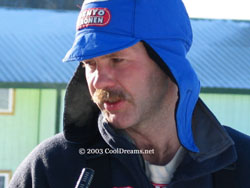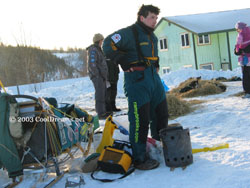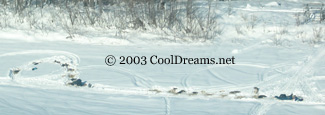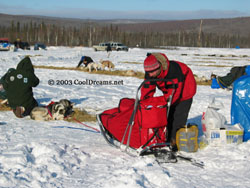|
 The
Norwegian musher who was 2002 Iditarod Rookie of the Year, Robert
Sorlie, reached Eagle Island on the Yukon River at 3:29 a.m. Friday,
maintaining his lead. He won $3,000 in gold nuggets for reaching
the halfway point first. His nearest competitors are Jeff King,
Martin Buser, Johnny Baker, and Rick Swenson. Sorlie's style reminds
me of what Swingley has done in the past, get out in front and stay
there. One of Sorlie's contacts says that is indeed part of the
strategy so that the Norwegian dogs will not pick up any virus or
infections from other teams as these dogs have not been in Alaska
long enough to acclimate and build up resistance to common bugs
here. Ramy Brooks had a small glitch when he was told in Ruby that
drop bag two of three was lost. The
Norwegian musher who was 2002 Iditarod Rookie of the Year, Robert
Sorlie, reached Eagle Island on the Yukon River at 3:29 a.m. Friday,
maintaining his lead. He won $3,000 in gold nuggets for reaching
the halfway point first. His nearest competitors are Jeff King,
Martin Buser, Johnny Baker, and Rick Swenson. Sorlie's style reminds
me of what Swingley has done in the past, get out in front and stay
there. One of Sorlie's contacts says that is indeed part of the
strategy so that the Norwegian dogs will not pick up any virus or
infections from other teams as these dogs have not been in Alaska
long enough to acclimate and build up resistance to common bugs
here. Ramy Brooks had a small glitch when he was told in Ruby that
drop bag two of three was lost.  That
was where Ramy's important items and best meat would've been. Mushers
can use meat from other mushers' bags who have scratched but by
doing so, run the risk of upsetting their dogs stomachs by introducing
new rations during race conditions. The look on Ramy's face definitely
showed dismay while he decided how to handle the situation. That
was where Ramy's important items and best meat would've been. Mushers
can use meat from other mushers' bags who have scratched but by
doing so, run the risk of upsetting their dogs stomachs by introducing
new rations during race conditions. The look on Ramy's face definitely
showed dismay while he decided how to handle the situation.
If you check the standings, several mushers have scratched already,
Jason Barron of Montana being the latest. Jason had dropped several
of his good leaders and felt that he did not have enough good lead-power
to continue on. Also scratched from the race were Lance Barve who
had to drop some of his leaders and scratched in Manley; Karen Land
had the same upsetting situation with leaders and dropped out in
Tanana; Blake Matray scratched in Tanana due to illness in his team;
Bob HIckel had dropped seven dogs and felt that he did not have
enough to go the rest of the way with the remaining team; Peter
Bartlett said his dogs were not eating properly and, sadly, it was
in their best interest to give it up in Tanana.
 Lynda
Plettner had some trouble on the trail caused by those crazy souls
who are walking, yes WALKING to Nome, the IditaSport group. They
are walking on the same trail where the teams are mushing but human
feet will punch through the snow crust where dogs and sleds will
not. She was not happy to have to drop a favorite dog whose wrist
was sprained by stepping into a footprint hole. According to Joe
Runyan, Lynda was still in high spirits, upbeat and the team was
eating well and looking good. Rick Swenson was one musher who thought
about the soft snow conditions and had specially purchased extra
wide plastic, a little over two inches wide, to replace the narrow
plastic that is standard on modern sleds. The wide plastic is much
better in soft snow because it gives the sled some lift. Rick, being
a trapper, knows that wide runners are better for a load in soft
snow. Little things like this can be an advantage when conditions
are challenging. Lynda
Plettner had some trouble on the trail caused by those crazy souls
who are walking, yes WALKING to Nome, the IditaSport group. They
are walking on the same trail where the teams are mushing but human
feet will punch through the snow crust where dogs and sleds will
not. She was not happy to have to drop a favorite dog whose wrist
was sprained by stepping into a footprint hole. According to Joe
Runyan, Lynda was still in high spirits, upbeat and the team was
eating well and looking good. Rick Swenson was one musher who thought
about the soft snow conditions and had specially purchased extra
wide plastic, a little over two inches wide, to replace the narrow
plastic that is standard on modern sleds. The wide plastic is much
better in soft snow because it gives the sled some lift. Rick, being
a trapper, knows that wide runners are better for a load in soft
snow. Little things like this can be an advantage when conditions
are challenging.
 Rookies
are having an different race this year than most and rookie Randy
Chappell of Texas is hanging near the top, maybe a candidate for
Rookie of the Year. Most of the complaints I have heard on the trail
so far were due to snow conditions being "punchy," attributable
to the weird winter Alaska has had. The next challenge of the trail
will be the passing of teams on the segment of trail between Grayling
and Kaltag where teams will travel down to Shageluk and Anvik meeting
teams heading back up to Kaltag the second time. With this loop,
the total distance of the trail will be about 100 miles longer than
the traditional Southern Iditarod loop. However, the situation will
be more normal when teams then go towards Unalakleet on the coast.
Unalakleet is a town of about 700 and typically has fierce winds
blowing off the Bering Sea. This race may be anything but normal.
We will have to wait and see. Rookies
are having an different race this year than most and rookie Randy
Chappell of Texas is hanging near the top, maybe a candidate for
Rookie of the Year. Most of the complaints I have heard on the trail
so far were due to snow conditions being "punchy," attributable
to the weird winter Alaska has had. The next challenge of the trail
will be the passing of teams on the segment of trail between Grayling
and Kaltag where teams will travel down to Shageluk and Anvik meeting
teams heading back up to Kaltag the second time. With this loop,
the total distance of the trail will be about 100 miles longer than
the traditional Southern Iditarod loop. However, the situation will
be more normal when teams then go towards Unalakleet on the coast.
Unalakleet is a town of about 700 and typically has fierce winds
blowing off the Bering Sea. This race may be anything but normal.
We will have to wait and see.
|



